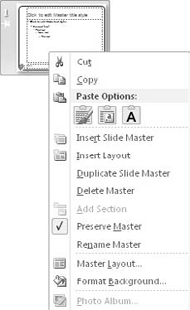Let's review the relationship one more time between
slide masters and themes. A theme is a set of formatting specs (colors,
fonts, and effects) that can be used in PowerPoint, Word, or Excel.
Themes are not applied directly to slides — they are applied to slide
masters, which govern the formatting of slides. The slide masters exist
within the presentation file itself. You can change them by applying
different themes, but they are essentially "built in" to the
presentation file.
When you change to a different
theme for all of the slides in the presentation, your slide master
changes its appearance. You can tweak that appearance in Slide Master
view. As long as all of the slides in the presentation use the same
theme, you need only one slide master. However, if you apply a different
theme to some of your slides, you need another master, because a master
can have only one theme applied to it at a time. PowerPoint
automatically creates the additional master(s) for you, and they are all
available for editing in Slide Master view.
If you later reapply a single
theme to all of the slides in the presentation, you do not need
multiple masters anymore, so the unused one is automatically deleted. In
addition to all this automatic creation and deletion of slide masters,
you can also manually create and delete slide masters on your own. Any
slide masters that you create manually are automatically preserved, even
if they aren't always in use. You must manually delete them if you
don't want them anymore.
In the following sections,
you learn how to create and delete slide masters manually, and how to
rename them. You also learn how to lock one of the automatically created
slide masters so that PowerPoint does not delete it if it falls out of
use.
1. Creating and Deleting Slide Masters
To create another slide
master, click Insert Slide Master on the Slide Master tab. It appears
below the existing slide master(s) in the left pane of Slide Master
view. From there, just start customizing it. You can apply a theme to
it, modify its layouts and placeholders, and all the usual things you
can do to a slide master. Another way to create a new slide master is to
duplicate an existing one. To do this, right-click the slide master and
choose Duplicate Master.
To delete a slide master,
select it in Slide Master view (make sure you select the slide master
itself, not just one of its layouts) and press the Delete key. If any of
that slide master's layouts were applied to any slides in the
presentation, those slides automatically convert to the default slide
master's equivalent layout. If no exact layout match is found,
PowerPoint does its best: It uses its default Title and Content layout
and includes any extra content as orphaned items.
2. Renaming a Slide Master
Slide master names appear as category headings on the Layout list as you are selecting layouts. For example, in Figure 1, the slide master names are Apex and Check.

To rename a slide master, follow these steps:
In Slide Master view, right-click the slide master and choose Rename Master. The Rename Master dialog box opens.
Type a new name for the master, replacing the existing name.
3. Preserving a Slide Master
Unless you have created the
slide master yourself, it is temporary. Slide masters come and go as
needed, as you format slides with various themes. To lock a slide master
so that it doesn't disappear when no slides are using it, right-click
the slide master and choose Preserve Master. A check mark appears next
to Preserve Master on its right-click menu, indicating it is saved. To
un-preserve it, select the command again to toggle the check mark off.
See Figure 2.
